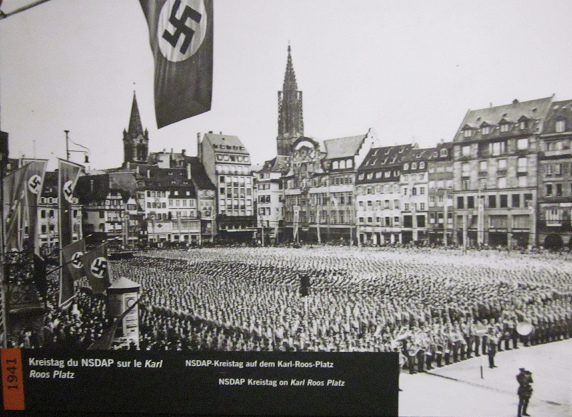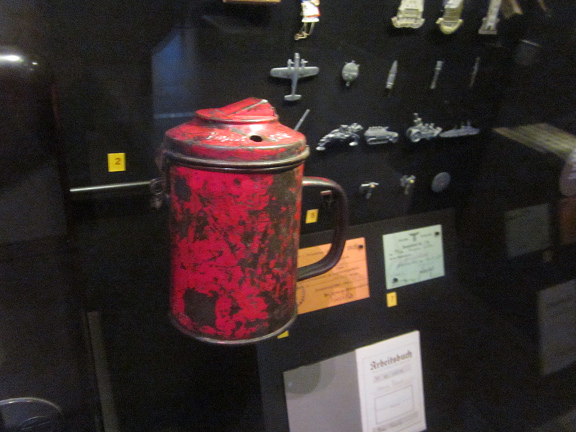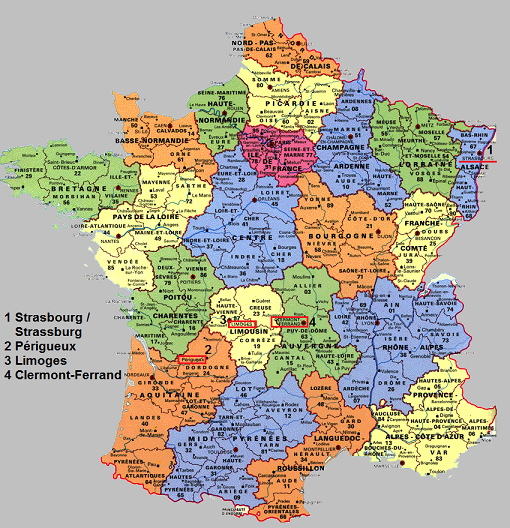|
|
|
| Share: |
Facebook |
|
Twitter
|
|
|
|
Second World War and National Socialist terrorism in Strasbourg
Evacuation of Strasbourg 1939-1940
After the Germans had attacked Poland on September 1, 1939, the French and British governments declared war on Germany on September 3, 1939. In Strasbourg was something special then because the border town was evacuated from September 1939 to July 1940. 100,000 were leaving their town to Dordogne and to the town of Limoges. The municipal council was shifted to the town of Perigueux [web01]. Strasbourg University was evacuated to the town of Clermont-Ferrand. Also the whole library was evacuated, but later after the Nazi occupation of Strasbourg after July 1940 was confiscated. This provoked much resistance within former students and professors and many of them were shot [museum web02].
Strasbourg and the important towns in Vichy France 1940-1944: Périgueux (2), Limoges (3) and Clermont-Ferrand (4) [1]
During 10 months there were mainly only soldiers left in the barracks of Strasbourg. In June 1940 German troops were occupying Strasbourg. And during the Nazi occupation all Alsace people were considered as Germans and were draught to the Wehrmacht. Many were evading this military service and disappeared in the underground in France [web01].
Nazi policy in Strasbourg 1940-1944
Now under the Nazi regime only German minded Alsace people were allowed to come back to Strasbourg [museum web02].
This was the welcome text at the Strasbourg train station in summer 1940 - but only "German minded" people was welcome... [2]
Nazi policy in Strasbourg
French minded Strasbourg people were not allowed to come back, but their possessings in Strasbourg were even confiscated by the Nazi administration. French monuments (Marseillaise, Kléber, Jeanne d'Arc and Kellerman) were destroyed and replaced by Nazi monuments. Also many names of streets were changes. German minded Strasbourg people could change their name into a German version sometimes. The aim of the Nazi regime was the destruction of the French language which was also performed with the introduction of the German school system. The synagogue was burnt in 1940 and was destroyed in 1941. All dwellers had to prove their descent for not being Jewish. The Nazi regime made it's normal propaganda for Hitler Youth, for the German Girls Association and for the Wehrmacht. At the end the population was morally dutied to give all values for the war away which was organized with "collections". At the same time the Alsatian soldiers were integrated into German troops at the Eastern Front (at a maximum of 15%). From 1942 on families from men who had evaded the Wehrmacht military service were punished by a deportation to Poland which affected 2.7% of the Strasbourg population [museum web02].

Regional Nazi parliament on Roos Square (French: Kleber Square) in Strasbourg - helmet of the German Wehrmacht in Strassburg [2]

A National Socialist collecting box - "collection of skis for Winter Help Network (may be more a confiscation of all skis of Strasbourg) [2]University and professors
At the Strasbourg University no French professor could work any more from 1940 on but only German professors were installed there. When the French professors of Strasbourg were foced to work in concentration camps for high technology the German Nazi professors in Strasbourg were working with a particle accelerator - which was "taken" later by the French. In the concentration camp of Natzweiler-Struthof Nazi professors from Strasbourg were executing human experiments with Jews and gypsies. Many French minded people from Strasbourg having fled to Limoges were in the resistance movement then. Allied bombings of the center were on August 11 and September 25 1944 [museum web02].
The deported French university professor Charles Sadron [2]The end
After the allied occupation of Strasbourg there were German bombing counter attacs yet - until 1945 [museum web02].
The French troops were under the command of general Jean de Lattre de Tassigny. After the Second World War the mayor Pierr Pflimlin was working for a reconciliation with Germany and Strasbourg became a symbol of friendship between the two countries and a symbol of European collaboration. Since 1948 it is the seat of the European Council [web01].
| Delen: |
Facebook |
|
Twitter
|
|
|
|
Sources
[web01] Wikipedia Straatsburg: http://nl.wikipedia.org/wiki/Straatsburg#Van_bisschopsstad_tot_burgerstad, Sep 30, 2014
[web02] Town's Museum of Strasbourg, visit in September 2014
Photo sources
[1] map of France: http://www.cartes-de-france.fr/carte_france.html
[2] Town Museum of Strasbourg, visit in September 2014
^
